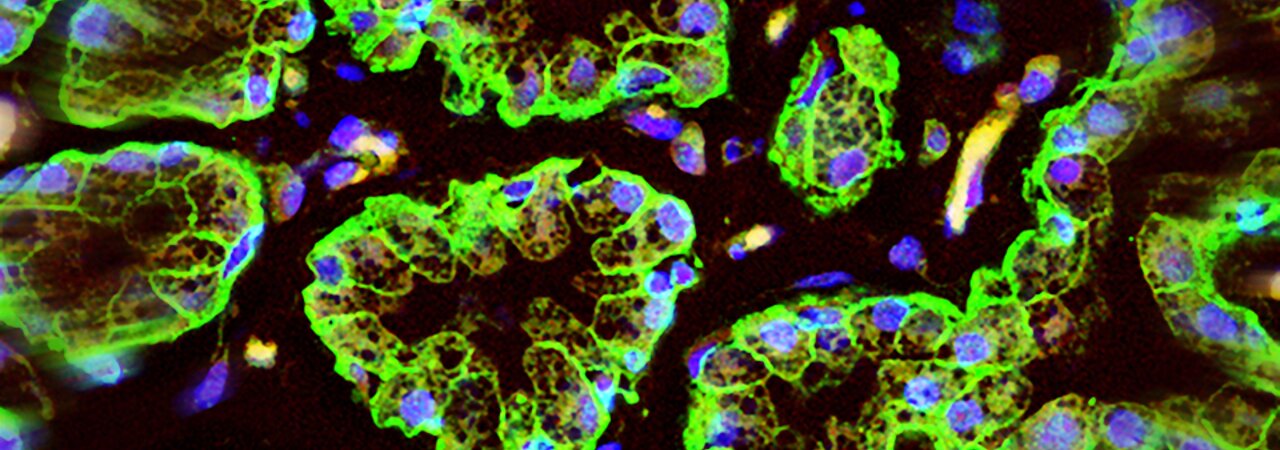母乳的好处
阅读时间:
母乳为宝宝的成长和发育所必需的所有营养成分, 包括各种宏量营养素(脂肪、碳水化合物和蛋白质)、微量营养素(维生素和矿物质)以及发育因子(长链多不饱和脂肪酸即 LCPUFA、生长因子和细胞因子)。母乳还具有保护作用,可通过免疫球蛋白和抗感染蛋白质等减少感染。因此,建议在宝宝出生头六个月以纯母乳喂养,之后再添加辅食的基础上母乳喂养至少一年。

母乳脂肪占足月产婴儿热量摄入量的 50%-60%。此外,脂肪在为宝宝提供游离脂肪酸和脂溶性维生素方面还起到重要作用。甘油三脂由不饱和脂肪酸与饱和脂肪酸组成,是母乳中含量最多的脂肪类,占总脂肪量的 98% 以上。二十二碳六烯酸 (DHA) 、花生四烯酸 (AA) 等 LCPUFA 尤为重要,因为这些物质积聚在大脑和视网膜的膜脂中,保证重要的视觉和神经功能。确实,宝宝的母乳摄入量越高,大脑皮层、灰质和白质中的 DHA 和 AA 血浆浓度水平就越高,而且宝宝到 15 岁时的智商也会高于用不含 LCPUFA 婴幼儿配方奶粉喂养的宝宝。
乳糖是母乳中的主要碳水化合物,为宝宝提供 30%-40% 的能量。乳糖是宝宝的主要能量来源,已被分解为葡萄糖和半乳糖。葡萄糖大多数被传入外周环流,作为产生能量的基质,但是肝脏吸收了半乳糖并将半乳糖转化为葡萄糖-1-磷酸盐,半乳糖逐渐被转化为葡萄糖或用于补充肝肌糖元贮备。大脑还可以利用半乳糖和葡萄糖产生能量,半乳糖对半乳糖脂(脑苷脂)的产生尤为重要,对宝宝中枢神经系统的发育必不可少。
母乳低聚糖 (HMO) 低聚糖是由三到十种单糖组成的复合碳水化合物。HMO 是母乳中的第三大营养成分,次于乳糖和三酰基甘油。因为小肠不消化吸收 HMO,所以 HMO 并不是宝宝的主要能量来源。但是,HMO 具有重要的免疫功能,起到益生元的作用,促进共生菌的肠道生长,尤其 Bifidobacterium longum subsp infantis 和 B.bifidum。同时还起到目标或受体类似物的作用,可抑制轮状病毒等病原菌粘附在肠道表面。HMO 还可以保护胃肠道,防止坏死性小肠结肠炎,对于早产儿(胎龄小于 36 周)可能尤为重要,因为他们更容易患 NEC。
蛋白质
蛋白质为宝宝提供大约 8% 的能量。母乳中的蛋白质超过 415,大部分是活性的,具有保护宝宝的功能。虽然不同妈妈的蛋白质水平差别很大,但是初乳中的蛋白质水平较高 (30-70g/l),而成熟乳的蛋白质水平较稳定,仅有 7-14g/l。母乳中的蛋白质可分为三种: 酪蛋白、乳清蛋白和与乳脂肪球膜相关的蛋白质。初乳中的乳清蛋白占总蛋白含量的绝大多数,而成熟奶中的乳清蛋白降至 60% 左右。
β-酪蛋白等蛋白质具有重要的抗菌和抗感染功能,可抑制细菌和病毒。此外,α-乳白蛋白的消化吸收所产生的缩氨酸对革兰氏阳性和革兰氏阴性菌具有很强的抑菌活性。母乳中的其它蛋白质(sIgA、乳铁蛋白和溶菌酶、巨噬细胞、游离脂肪酸等)也都能够发挥抗感染剂的作用,是早产儿所必需的。这些抗感染剂共同协同作用,抑制、杀死或结合某些微生物,防止微生物粘附在粘膜表面。
同时,母乳中含有的保护性共生菌成为肠道菌群的一部分,影响炎性和免疫调节过程。共生菌不仅抑制病原菌的过度生长,还降低肠道pH值、发酵乳糖、分解脂质和蛋白质并产生维生素 K 和维生素 H。
母乳为宝宝提供脂溶性维生素、水溶性维生素、矿物质和微量矿物质等微量营养素,这些营养素都取决于妈妈的饮食。钙和磷酸盐虽然与产妇饮食摄入量无关,但却是酪蛋白胶粒的主要成分,是骨矿化所需要的。母乳中的微量元素包括铜、锌、钡、镉、铯、钴、铈、镧、锰、钼、镍、铅、铷、锡和锶,仅在母乳中才具有高生物有效性。
母乳含有母体活细胞,包括血液白细胞、乳腺上皮细胞和红细胞碎片。白血球既保护妈妈又对宝宝有免疫保护作用。母乳中还有干细胞,在体外乳腺分化条件下可分化为乳腺上皮细胞谱系,以及微环境中的其它细胞,包括骨细胞、脑细胞、肝细胞、胰岛 β 细胞和心肌细胞。干细胞对宝宝的作用仍未确定,需要进一步研究才能了解其作用。
人造乳制品不可代替母乳成分,尤其是母乳干细胞。纯母乳喂养可满足足月宝宝头六个月的营养需求,之后在添加辅食的基础上继续母乳喂养两年。
Human milk oligosaccharides and their potential benefits for the breast-fed neonate
Human milk oligosaccharides (HMO), unconjugated complex carbohydrates that are highly abundant in human milk but not in infant formula, have recently received much attention due...
Jantscher-Krenn E, Bode L (2012)
Proteome mapping of human skim milk proteins in term and preterm milk
The abundant proteins in human milk have been well characterized and are known to provide nutritional, protective, and developmental advantages to both term and preterm ...
Molinari CE1, Casadio YS, Hartmann BT, Livk A, Bringans S, Arthur PG, Hartmann PE (2012)
Bode, L. Human milk oligosaccharides: every baby needs a sugar mama. Glycobiology 22, 1147-1162 (2012).
Caicedo, R.A. et al. The developing intestinal ecosystem: implications for the neonate. Pediatr.Res. 58, 625-628 (2005).
Claud, E. C. Probiotics and neonatal necrotizing enterocolitis. Anaerobe 17, 180-185 (2011).
Cregan, M.D. et al. Identification of nestin-positive putative mammary stem cells in human breastmilk. Cell Tissue Res 329, 129-136 (2007).
Fleith, M. and Clandinin, M.T. Dietary PUFA for preterm and term infants: review of clinical studies. Crit Rev Food Sci Nutr 45, 205-229 (2005).
Fransson, G.B. and Lonnerdal, B. Zinc, copper, calcium, and magnesium in human milk. J.Pediatr. 101, 504-508 (1982).
Froehlich, J.W. et al. Glycoprotein expression in human milk during lactation. J.Agric.Food Chem. 58, 6440-6448 (26-5-2010).
Garrido, D. et al. Oligosaccharide binding proteins from Bifidobacterium longum subsp. infantis reveal a preference for host glycans. PLoS.One. 6, e17315 (2011).
Gartner, L.M. et al. Breastfeeding and the use of human milk. Pediatrics 115, 496-506 (2005).
Hale, T. W. and Hartmann, P. E. Textbook of Human Lactation 2007a).
Hale, T. W. and Hartmann, P. E. Textbook of human lactation (Hale Publishing LLP, Amarillo TX, 2007b).
Hassiotou, F. et al. Breastmilk is a novel source of stem cells with multilineage differentiation potential. Stem Cells 30, 2164-2174 (2012a).
Hassiotou, F. and Geddes, D. Anatomy of the human mammary gland: Current status of knowledge. Clin Anat(19-9-2012b).
Innis, S.M. Dietary triacylglycerol structure and its role in infant nutrition. Adv.Nutr. 2, 275-283 (2011).
Jantscher-Krenn, E. et al. The human milk oligosaccharide disialyllacto-N-tetraose prevents necrotising enterocolitis in neonatal rats. Gut 61, 1417-1425 (2012).
Jensen, Robert G Handbook of milk composition (Academic Press, San Diego, 1995).
Khan, S. et al. Variation in Fat, Lactose, and Protein Composition in Breast Milk over 24 Hours: Associations with Infant Feeding Patterns. J Hum Lact Online ahead of Print, (2012).
Kunz, C. and Lonnerdal, B. Re-evaluation of the whey protein/casein ratio of human milk. Acta Paediatr. 81, 107-112 (1992).
Molinari, C.E. et al. Proteome mapping of human skim milk proteins in term and preterm milk. J Proteome Res 11, 1696-1714 (2-3-2012).
Neu, J. Neonatal necrotizing enterocolitis: an update. Acta Paediatr.Suppl 94, 100-105 (2005).
Neville, M. Physiology of lactation. Clin Perinatol 26, 251-79, v (1999).
Newburg, D.S. and Walker, W.A. Protection of the neonate by the innate immune system of developing gut and of human milk. Pediatr Res 61, 2-8 (2007).
Saarela, T., Kokkonen, J. & Koivisto, M. Macronutrient and energy contents of human milk fractions during the first six months of lactation. Acta Paediatr. 94, 1176-1181 (2005).
Sela, D.A. et al. An infant-associated bacterial commensal utilizes breast milk sialyloligosaccharides. J Biol Chem 286, 11909-11918 (8-4-2011).
Shulman, R.J., Wong, W.W. & Smith, E.O. Influence of changes in lactase activity and small-intestinal mucosal growth on lactose digestion and absorption in preterm infants. Am.J.Clin.Nutr. 81, 472-479 (2005).
Thomas, E. et al. Transient Silencing of 14-3-3sigma promotes proliferation of p63-positive progenitor cells isolated from human breastmilk in mammary epithelial cell culture. unpublished(2010).
Wade, N. Breast milk sugars give infants a protective coat. New York Times (3-8-2010).
WHO and UNICEF. Global strategy for infant and young child feeding (World Health Organization, Geneva, 2003).
Wu, S. et al. Annotation and structural analysis of sialylated human milk oligosaccharides. J Proteome Res 10, 856-868 (4-2-2011).
感兴趣的文章